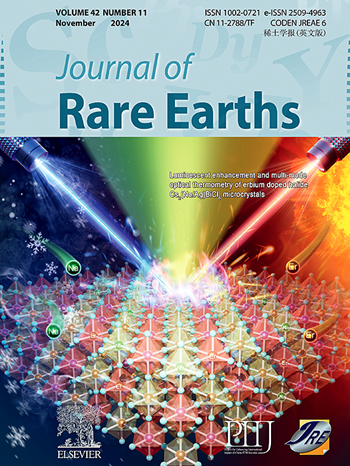气敏用受限稀土二氧化铈纳米颗粒薄膜:实验与理论研究
IF 7.2
1区 化学
Q1 CHEMISTRY, APPLIED
引用次数: 0
摘要
小粒径的纳米结构材料由于其高比表面积和表面活性而被广泛应用于电阻式气体传感器中。然而,在器件制造或传感测试过程中,纳米结构的团聚、生长和结构损伤等现象几乎是不可避免的,这使得纳米结构难以发挥其预期的活性。为了解决这一问题,我们选择稀土金属氧化物CeO2作为模型材料来探索电阻式气体传感器的受限纳米结构。实验成功地采用脉冲激光沉积结合快速退火技术制备了受限氧化铈纳米颗粒薄膜。实验结果表明,封闭的CeO2纳米颗粒薄膜能够有效地检测挥发性有机化合物三乙胺,对100 ppm三乙胺的响应率为20 (Ra/Rg),响应时间为2s,具有良好的稳定性和选择性。通过原位约束在多孔碳基体中,可以实现CeO2纳米颗粒的分散和固定,从而充分利用其高表面活性。此外,多孔碳基质可以作为目标气体分子和电子的传输途径,实现高效的气固反应和有效的气敏信号收集。更重要的是,在商用氧化铝平板气敏衬底上原位生长了受限的CeO2纳米颗粒薄膜,该薄膜可直接用作气敏传感器的传感层。基于第一性原理计算,在原子和电子尺度上系统分析了受限氧化铈纳米颗粒薄膜的三乙胺传感机理。该研究为通过限制纳米结构设计来提高电阻式气体传感器的气敏性能提供了新的见解。本文章由计算机程序翻译,如有差异,请以英文原文为准。

Confined rare earth cerium dioxide nanoparticles film for gas sensing: Experimental and theoretical studies
Nanostructured materials with small particle sizes have been widely used in resistive gas sensors due to their high specific surface area and surface activity. However, phenomena including agglomeration, growth and structural damage of nanostructures are almost inevitable during the processes of device fabrication or sensing tests, which makes it difficult to exert their expected activity. To address this issue, rare earth metal oxide CeO2 was chosen as the model material to explore confined nanostructures in resistive gas sensors. The experiment successfully achieves the preparation of confined CeO2 nanoparticles film using a pulsed laser deposition combined with rapid annealing technology. It is found that the confined CeO2 nanoparticles film enables the efficient detection of volatile organic compound triethylamine, demonstrating a significant response of 20 (Ra/Rg) towards 100 ppm triethylamine, a fast response of 2 s, excellent stability and selectivity. By in-situ confinement in porous carbon matrix, dispersion and fixation of CeO2 nanoparticles can be achieved, thereby fully utilizing their high surface activity. In addition, the porous carbon matrix can serve as a transport pathway for the target gas molecules and electrons, enabling efficient gas–solid reactions and effective collection of gas sensing signals. More importantly, the confined CeO2 nanoparticles film was grown in-situ on commercial alumina flats gas sensing substrate, which can be directly used as sensing layer for gas sensors. Based on first-principles calculations, the triethylamine sensing mechanism of the confined CeO2 nanoparticles film was systematically analyzed at the atomic and electronic scale. This study offers new insights into enhancing the gas sensing performance of resistive gas sensors through confined nanostructures design.
求助全文
通过发布文献求助,成功后即可免费获取论文全文。
去求助
来源期刊

Journal of Rare Earths
化学-应用化学
CiteScore
8.70
自引率
14.30%
发文量
374
审稿时长
1.7 months
期刊介绍:
The Journal of Rare Earths reports studies on the 17 rare earth elements. It is a unique English-language learned journal that publishes works on various aspects of basic theory and applied science in the field of rare earths (RE). The journal accepts original high-quality original research papers and review articles with inventive content, and complete experimental data. It represents high academic standards and new progress in the RE field. Due to the advantage of abundant RE resources of China, the research on RE develops very actively, and papers on the latest progress in this field emerge every year. It is not only an important resource in which technicians publish and obtain their latest research results on RE, but also an important way of reflecting the updated progress in RE research field.
The Journal of Rare Earths covers all research and application of RE rare earths including spectroscopy, luminescence and phosphors, rare earth catalysis, magnetism and magnetic materials, advanced rare earth materials, RE chemistry & hydrometallurgy, RE metallography & pyrometallurgy, RE new materials, RE solid state physics & solid state chemistry, rare earth applications, RE analysis & test, RE geology & ore dressing, etc.
 求助内容:
求助内容: 应助结果提醒方式:
应助结果提醒方式:


